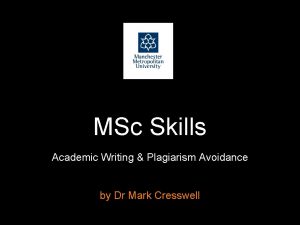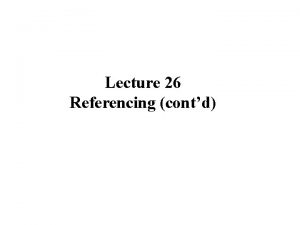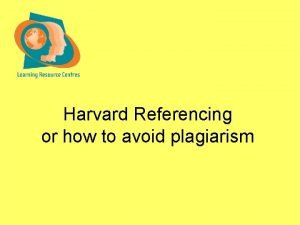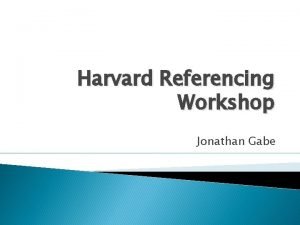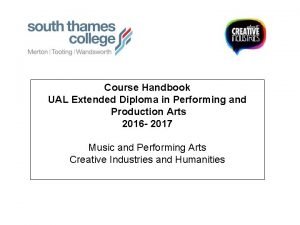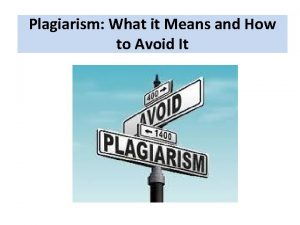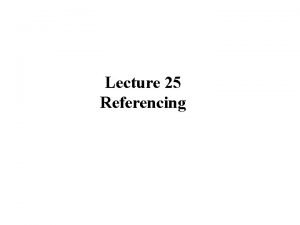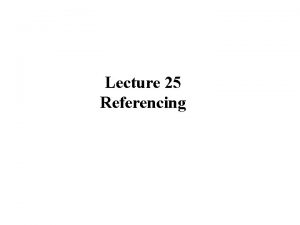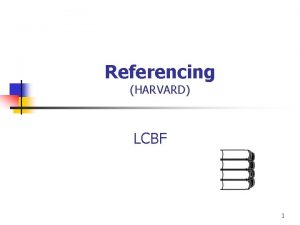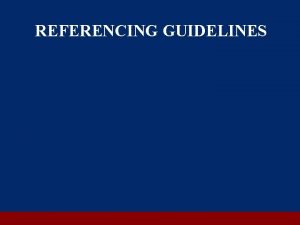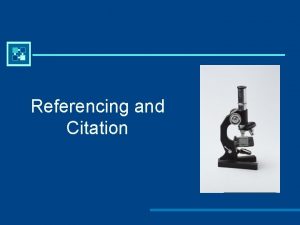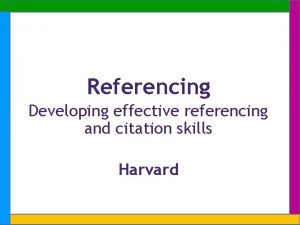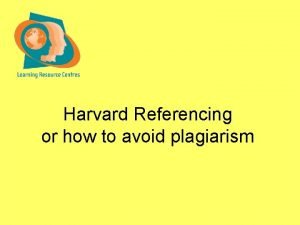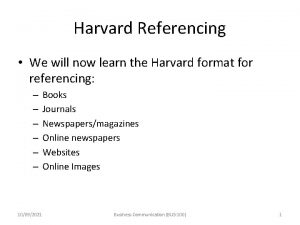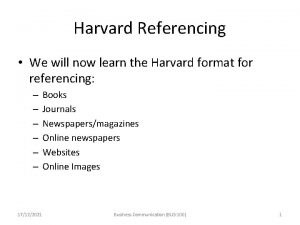Referencing Systems Workshop structure Why reference Harvard referencing


























- Slides: 26

Referencing Systems

Workshop structure • Why reference? • Harvard referencing system • Footnote (Oxford) referencing system

Why reference? • Lecturers want to see evidence of research and reading. • Show off your reading/extent of your reading. • You should also reference your work so that you are not plagiarising the work of others. • It’s essential for degree level study.

Harvard: where Reference in two places: • In-text reference with brackets • Full reference – appears in the reference list or bibliography at the end (in alphabetical order by author surname)

Harvard: textbooks Direct quotes from a single author: “It is a task of every sociological theory to clarify the characteristics that all possible human societies have in common. ” (Elias, 1994, p 186) or As Elias (1994, p 186) points out, “it is a task of every sociological theory to clarify the characteristics that all possible human societies have in common. ”

Harvard: textbooks If you are talking about an author in your own words, you should reference it like this (i. e. no page number required): It has been argued that all sociological theory strives to make sense of human society (Elias, 1994). or Elias (1994) has argued that all sociological theory strives to make sense of human society.

Harvard: textbooks The full reference appears in your reference list (bibliography): Elias, N. 1994. The Civilising Process. Oxford: Blackwell So the convention is: Surname, Initials. Year of publication. Title. Place of publication: Publisher’s name

Harvard: textbooks Scenario In-text reference Full reference 1 author (Borthwick, 2010) Borthwick, D. 2010. Title of book. Town published: Publisher’s name 2 authors (Smith and Jones, 1994) Smith, A. and Jones, K. 1994. Title of book. Town published: Publisher’s name 3 or more authors (White et al. , 2002) White, M. , Green, A. and Black, S. 2002. Title of book. Town published: Publisher’s name

Harvard: journals In the text it is exactly the same as the referencing for a textbook. However, in your reference list it should look like this: Smith, J. 1995. The End of Enlightenment: A Study of Reality TV Audiences in Britain. European Journal of Cultural Studies. vol. 6 (no. 2) pp 126 -138 i. e. Surname, Initials. Year. Name of the article. Name of the journal. Volume number (issue number) Page numbers

Harvard: secondary sources If an author quotes or refers to the work of another author, and you wish to use it, you must acknowledge that it is a secondary source. You do this by naming both authors within the text as follows: Habermas (cited in Scott, 1999, p 238) states that “our first sentence expresses ……”

Harvard: secondary sources Only the details of the book you have read go into the reference list. For example: Scott, A. 1999. Social Theory. Cambridge: Polity.

Harvard: edited collections If you are quoting from an article in an edited collection, the abbreviated reference should contain the name of the author of that article and the date that the edited collection was published. For example, the following quotation is taken from a piece by Jurgen Habermas which appears in a book edited by Patricia Waugh. “Aesthetic modernity is characterised by attitudes which find a common focus in a changed consciousness of time. ” (Habermass, 1992, p 161).

Harvard: edited collections The full reference should appear as follows: Habermas, J. 1992. Modernity – An Incomplete Project. in P. Waugh, ed. 1992. Postmodernism: A Reader. London: Edward Arnold

Harvard: websites In-text example: Access to safe drinking water has increased by 13% during the past 5 years (WHO, 2009) or According to WHO (2009) access to safe drinking water has increased by 13% during the past 5 years.

Harvard: websites The full reference in your reference list will look like this: World Health Organisation. 2009. World Health Statistics 2009. [online]. Available from: http: //neal. ctstateu. edu/history/cite. html [Accessed 3 April 2010]

Suffixes If you have a two or more sources by the same author for the same year you should use suffixes For example: Two documents by WHO for 2013 In-text references: (WHO, 2013 a) and (WHO, 2013 b) Full references: World Health Organisation. 2013 a. World Malaria Report 2013. [online]. Available from: http: //apps. who. int/iris/bitstream/10665/97008/ 1/9789241 564694_eng. pdf [Accessed 3 March 2014] World Health Organisation. 2013 b. WHO AIDS Medicines Report 2013. [online]. Available from: http: //apps. who. int/iris/bitstream/10665/104451/ 1/9789241506755_eng. pdf [Accessed 21 January 2014]

Harvard: other sources Source In-text reference Full reference Newspaper (Anon, 2013) Anon. 20 Oct 2013. Marriage rates falling for third year, in The Observer Magazine (Husain, 2012) Husain, L. March 2013. China’s missing girls, in Marie Claire Leaflet (Save the Children, n. d. ) Save the Children. n. d. Fostering in Fife, Leaflet TV (Goodman, programme 2010) Goodman, P. 2010. Are we getting fatter? BBC documentary for Panorama Email (Grierson, 2013) Grierson, N. 21 Oct 2013. Email Interview (Grierson, 2011) Grierson, N. 30 Oct 2013. Interview

Footnote system: where Reference in three places: • In-text footnote number appears (use Word to create footnotes) • Full reference appears at the bottom of each page • Full reference appears in the bibliography at the end (in alphabetical order by author surname)

Why use footnote system? • Standard for certain disciplines (law, history) • You can see exactly where the source came from quickly and without turning to the back of the document • More robust - easier to check up

Footnote system: characteristics Footnotes appear in chronological order and at the end of the sentence after the full stop. For example: According to Bevan, Italy constituted the main threat to the allies during the later half of the Second World War. 1 or “Italy constituted the main threat to the allies during the later half of the Second World War”. 1

Footnote system: convention • Differs to Harvard – components of the reference are set out in a different order. • The bibliographical reference at the end is set out differently to the footnote reference. • Page numbers are always included – not just for a direct quote.

Footnote system: textbook • Footnote: P. Lloyd, Cold War, Sage, Cambridge, 1996, p. 64 • Reference list: Lloyd, P. , Cold War (Sage: Cambridge, 1996)

Footnote system: journal • Footnote: H. Sabre, T. Johan and C. Jack, ‘Manual workers’ attitudes to anti-semitism in Germany 1932 -1939’. Journal of Historical Social Research, vol 122, no. 2, 2013, pp. 401402 • Reference list: Sabre, H. Johan, T. and Jack, C. , ‘Manual workers’ attitudes to anti-semitism in Germany 1932 -1939’. Journal of Historical Social Research, vol 122, no. 2 (2013) pp. 401 -449

Footnote system: websites • Footnote: G. Megargee, ‘Hitler’s Leadership Style’, in History: Knowledge and Learning Beta. BBC, 30 March 2011, viewed on 5 November 2013, http: //www. bbc. co. uk/history/worldwars/wwtwo/hitler_commander_01. shtml • Reference list: Megargee, G. , ‘Hitler’s Leadership Style’, in History: Knowledge and Learning Beta. BBC, 30 March 2011, viewed on 5 November 2013, http: //www. bbc. co. uk/history/worldwars/wwtwo/hitler_commander_01. shtml

Footnote system: shortcuts • ‘ibid’ can be used when two footnotes appear in a row for the same source. For example: 11. P. Lloyd, Cold War, Sage, Cambridge, 1996, p. 64 12. ibid. , p. 79 • ‘op. cit’ can be used when a reference that has already been footnoted appears again later (but not straight after the earlier reference). For example: 10. P. Lloyd, Cold War, Sage, Cambridge, 1996, p. 64 11. S. Field, British Foreign Policy: 1929 -1939, Routledge, Manchester, 1988, p. 243 12. Lloyd, op. cit. , p. 66

Help! • nyreegrierson@fife. ac. uk • Look out for referencing in textbooks • Be consistent • Online resources (Neil’s Toolbox; university online resources)
 Hey hey bye bye
Hey hey bye bye Harvard vs vancouver
Harvard vs vancouver Rgu harvard referencing
Rgu harvard referencing In-text referencing harvard
In-text referencing harvard Mmu harvard referencing
Mmu harvard referencing Harvard referencing lecture
Harvard referencing lecture Harvard style referencing article
Harvard style referencing article How to reference a case study in harvard style
How to reference a case study in harvard style Bibliography harvard method
Bibliography harvard method How to harvard reference a book
How to harvard reference a book Aru referencing
Aru referencing Gcu harvard referencing
Gcu harvard referencing Uts library referencing
Uts library referencing Maslow 1943 harvard reference
Maslow 1943 harvard reference Imperial harvard referencing
Imperial harvard referencing Ou harvard referencing
Ou harvard referencing Harvard referencing formula
Harvard referencing formula Https://smallseotools.com/plagiarism-checker/
Https://smallseotools.com/plagiarism-checker/ Ual level 3 performing and production arts
Ual level 3 performing and production arts Narrabeen man
Narrabeen man Harvard referencing formula
Harvard referencing formula What is this image
What is this image Harvard referencing utar
Harvard referencing utar Harvard referencing neils toolbox
Harvard referencing neils toolbox Reference source
Reference source Dcu harvard referencing
Dcu harvard referencing Newman harvard referencing
Newman harvard referencing




